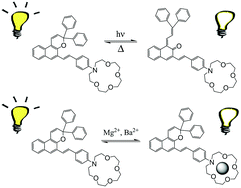Fluorescent properties of an azacrown-containing styryl derivative of naphthopyran: ion-binding response and photochemical switching off†
Abstract
The fluorescent properties of a recently synthesized photochromic

* Corresponding authors
a
Voevodsky Institute of Chemical Kinetics and Combustion, 3 Institutskaya str., Novosibirsk, Russia
E-mail:
smolentsev@kinetics.nsc.ru
Fax: +7 383 3307350
Tel: +7 383 3309150
b Novosibirsk State University, 2 Pirogova str., Novosibirsk, Russia
c
Nesmeyanov Institute of Organoelement Compounds, 28 Vavilova str., Moscow, Russia
E-mail:
fedorova@ineos.ac.ru
The fluorescent properties of a recently synthesized photochromic

 Please wait while we load your content...
Something went wrong. Try again?
Please wait while we load your content...
Something went wrong. Try again?
A. B. Smolentsev, E. M. Glebov, V. V. Korolev, S. V. Paramonov and O. A. Fedorova, Photochem. Photobiol. Sci., 2013, 12, 1803 DOI: 10.1039/C3PP50051A
To request permission to reproduce material from this article, please go to the Copyright Clearance Center request page.
If you are an author contributing to an RSC publication, you do not need to request permission provided correct acknowledgement is given.
If you are the author of this article, you do not need to request permission to reproduce figures and diagrams provided correct acknowledgement is given. If you want to reproduce the whole article in a third-party publication (excluding your thesis/dissertation for which permission is not required) please go to the Copyright Clearance Center request page.
Read more about how to correctly acknowledge RSC content.
 Fetching data from CrossRef.
Fetching data from CrossRef.
This may take some time to load.
Loading related content
